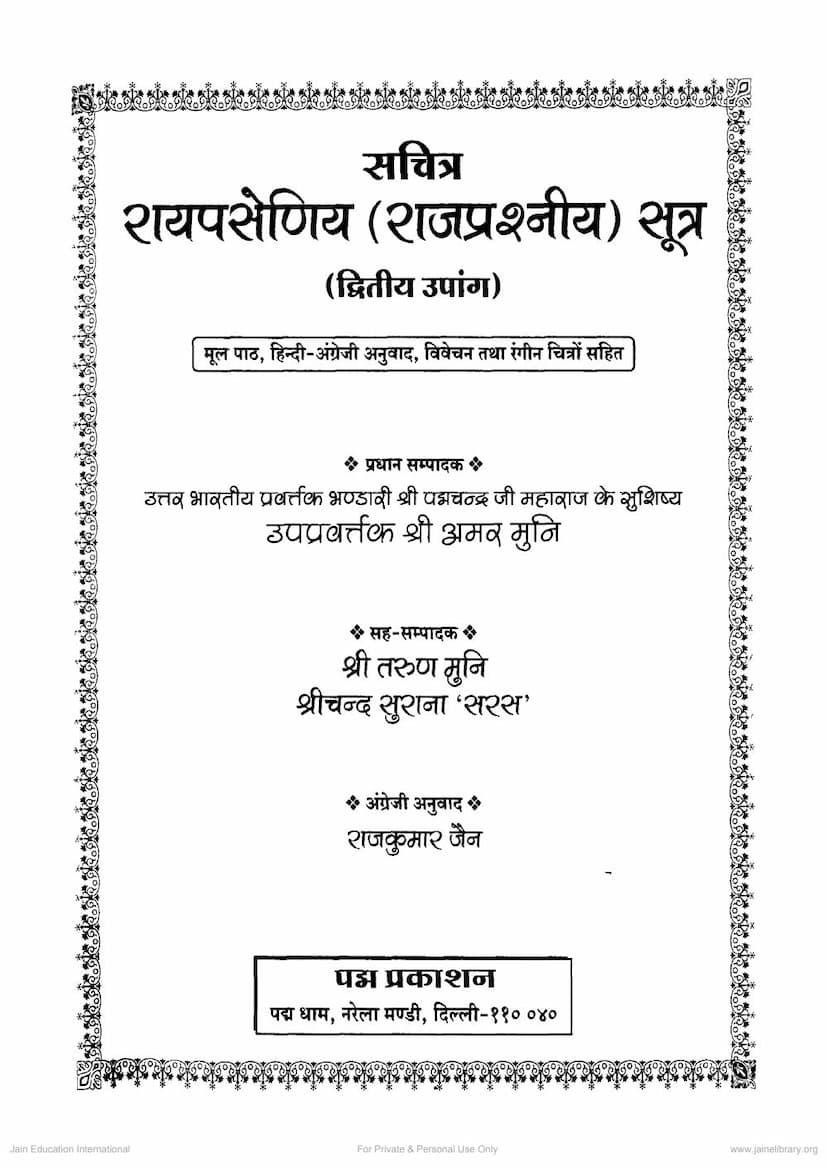Agam 13 Upang 02 Rajprashniya Sutra Sthanakvasi
Added to library: September 1, 2025

Summary
This document is the Rai-paseniya Sutra (Rajprashniya Sutra), which is the second Upanga within the Jain Agam literature, specifically linked to the Sutrakritanga Sutra. This particular edition is published by Padma Prakashan and edited by Up-pravartak Shri Amar Muni, with Associate Editors Shri Tarun Muni and Srichand Surana 'Saras'. The English translation is by Raj Kumar Jain, and the illustrations are by Dr. Trilok Sharma.
The text itself provides the original Jain Prakrit text, along with Hindi and English translations, an elaboration, and numerous colored illustrations.
Here's a comprehensive summary of the content presented, based on the provided text:
Core Purpose and Theme:
The central purpose of the Rai-paseniya Sutra, as stated in the introduction, is to propagate the soul and to infuse faith and belief in the soul within every seeker. It aims to establish the independent existence of the soul and its eternal, indestructible nature, in contrast to the body, which is described as ephemeral and destructible. The scripture also highlights how faith in religion and spiritual life can transform an individual, leading to profound changes in character and outlook.
Structure and Key Characters:
The scripture is primarily structured around two main characters:
- King Pradeshi: The agnostic and atheistic ruler of Shvetambika city. He is depicted as cruel, harsh, and inimical to religion, initially believing the body and soul to be one.
- Keshi Kumar Shraman: A wise and knowledgeable Jain monk, a follower of Bhagavan Parshvanath, endowed with four kinds of knowledge. He engages in a debate with King Pradeshi to establish the truth about the soul.
Narrative and Content:
-
The Illustrated Agam Series: This is presented as the thirteenth publication in the "Illustrated Agam Series" by Padma Prakashan.
-
Inspiration for the Publication: The publication is inspired by the message of the late Gurudev Rashtrasant Uttar Bharatiya Pravartak Bhandari Shri Padma Chandra ji Maharaj, emphasizing "Imparting knowledge to others is the greatest charity."
-
Unique Style: The Rai-paseniya Sutra is noted for its unique style. It tackles profound, complex, and potentially dry subjects like soul, religion, and spirituality by presenting them in a simple, engaging, and attractive manner, making them accessible and interesting to the masses.
-
The Debate: The core of the text revolves around the philosophical debate between King Pradeshi and Keshi Kumar Shraman regarding the existence and nature of the soul. King Pradeshi uses his experience and logic to argue for the oneness of body and soul, while Keshi Kumar Shraman refutes his arguments with compelling examples and logic, proving the soul's independent and eternal identity.
-
Transformation of King Pradeshi: The scripture details the astonishing transformation of King Pradeshi from a cruel, agnostic ruler to a devoted follower of Jainism after his discourse with Keshi Kumar Shraman. His life story serves as a testament to the power of spiritual discourse.
-
Suryabh Dev and Celestial Descriptions: A significant portion of the text is dedicated to the elaborate and poetic descriptions of Suryabh Dev, a celestial being from Saudharma Devlok. It details his grand celestial vehicles (Vimans), the structure of celestial abodes, his anointing ceremony, and various divine performances, plays, and musical instruments. These descriptions are rich in detail, highlighting ancient Indian art, culture, and civilization. The purpose of these celestial descriptions is to make the abstract concepts of soul and spirituality more relatable and interesting through vivid imagery.
-
Detailed Descriptions of the Viman: The text provides highly detailed descriptions of Suryabh Dev's celestial vehicle, including:
- Its immense size (one lakh yojans).
- Its construction from various precious jewels.
- The ornate design of its pillars, thrones, seating arrangements, gates, flags, and surrounding forests and lakes.
- The artistic representations of various beings and natural elements within the Viman.
- The meticulous cleaning and beautification rituals performed before Suryabh Dev's presence.
- The grand coronation ceremony of Suryabh Dev, involving numerous gods and goddesses, the preparation of various sacred materials, the exchange of gifts, and the performance of dance, music, and drama.
-
Spiritual Practices and Transformation: The story of Suryabh Dev's journey from his celestial existence to his reverence for Bhagavan Mahavir and the subsequent events illustrate the pursuit of spiritual knowledge and the transformation that can occur through such encounters.
-
The Five Sections of the Narrative: The content can be broadly divided into five sub-sections:
- Description of celestial vehicles.
- Arrival in the Samavasaran (Bhagavan Mahavir's divine congregation).
- The episode of Suryabh Dev.
- The dialogue between King Pradeshi and Keshi Kumar Shraman.
- The future incarnation of Suryabh Dev as Dridh Pratijna Kumar.
-
Elaboration on Terminology: The text emphasizes the need for detailed explanations of archaic or technical terms used in the Agam, especially in the descriptions of celestial realms, to ensure the understanding of the reader.
-
Reference Works: The commentary by Acharya Malayagırı is identified as the primary reference for understanding the text.
-
Illustrations: The presence of colored illustrations is highlighted as enhancing the understanding and appeal of the text.
-
Contribution to Understanding Ancient India: The scripture is valued for providing insights into ancient Indian art, culture, and civilization, particularly in its detailed descriptions of celestial realms, musical instruments, and dramatic performances.
-
The Importance of the Edition: The Hindi translation and elaboration by Shri Srichand Surana 'Saras' and the English translation by Shri Raj Kumar Jain are acknowledged for their contribution to making the text accessible to a wider audience.
In essence, the Rai-paseniya Sutra, as presented in this edition, is a comprehensive Jain scripture that uses vivid storytelling, celestial descriptions, and philosophical discourse to convey the fundamental Jain principles about the soul, karma, spirituality, and the potential for human transformation through righteous conduct. The detailed descriptions of celestial grandeur serve as a powerful narrative tool to captivate the reader and lead them to the profound spiritual message embedded within the text.